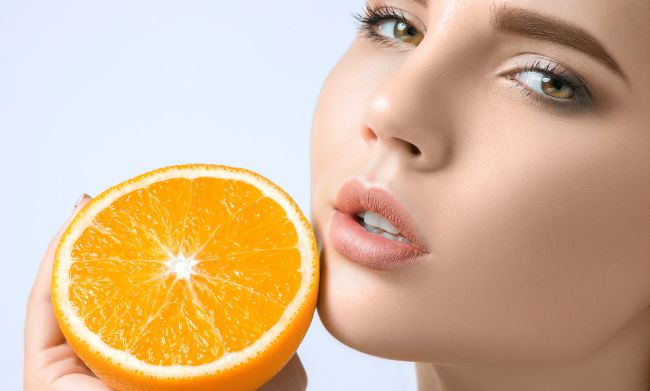Seeing through Vitamin C!
As we move out of the lockdown mode towards a new normal and with the festive season around the corner, brightening treatments are back in demand. Kanishka Ramchandani explores the importance of topical applications of vitamin C in post-treatment care routine.
The pandemic and the subsequent lockdowns have drastically changed our lifestyles. Today, aesthetic practitioners are looking at the effects of these changes on the demand for skincare treatments and products. A constrained lifestyle, constant exposure to indoor environment and electronic devices and change in eating habits have given rise to a gamut of skincare concerns. Dull, lustreless skin, pigmentation, uneven skin tone, fine lines and under eye stress lines are some of the most common complaints. Given the increase in demand for in-clinic skin rejuvenation treatments – in other words, ‘get glowing’ treatments – the post treatment routine has become a key concern.
In this feature, created in collaboration with Orange Daily, Aesthetic Medicine explores the importance of vitamin C in topical application for faster skin recovery and long-lasting results of brightening treatments.
Get glowing

Dr Aparna Santhanam,
Skin brightening treatments refers to a motley of treatments that are targeted at uneven skin tone, patchy pigmentation, pigmentary scars and spots. A client walking into a dermatologist’s clinic is not likely to use these terms as she is more interested in the end result, which is getting a glowing skin. Skin experts who understand the nuances of a client’s demands know that glowing skin can be achieved only with a combination of in-clinic treatments, at-home care and balanced nutrition. According to Dr Aparna Santhanam, Holistic Clinical Dermatologist and Cosmetologist, microdermabrasion, chemical peels of differing penetrations such as glycolic acid, mandelic salicylic acid and trichloroacetic acid peels are useful in skin lightening.

Dr Neetu Rajdeo
Dr Neetu Rajdeo, Cosmetic Dermatologist and Medical Director, Skinhance Skincare and Laser Clinic, states, “Indian skin is prone for tanning and pigmentation as our skin has the tendency to heal with pigmentation. In India, people are also obsessed with the concept of ‘fairness’ because to them ‘beautiful’ means ‘fair skin.’ So, there is a demand for brightening treatments. The brightening treatments that I offer at the Skinhance Clinic include medifacials, skin polishing, peels, Mesoporation, Q switch laser and PRP.”

Dr Shaefali Trasi
The lockdown and the subsequent trend of working from home has had a significant impact on people’s skin conditions and their care routine. Dr Shefali Trasi Nerurkar, Consultant Dermatologist, Dr Trasi clinic and La Piel skin clinic, explains, “With the lockdown opening up, people have realised that the glow on their faces have diminished with constant exposure to visible light sources such as laptops, tablets and mobiles. In India, the festival season also begins from the month of Shravan, with people socialising more. Social media has also created an awareness among everyone for a glowing bright skin. Brightening treatments have become the most popular treatments in aesthetic practice. Patients from the age of 15 and up want to opt for these treatments. Procedures such as chemical peels, microdermabrasion, medi facials, photofacials, vampire facials or face rejuvenation are regularly opted to attain natural glowing skin.”
At-home care
As the skin is extremely sensitive post a chemical peel, at-home care is of utmost importance. Topical applications help the skin recover faster and aid in maximising the benefits of the treatment. Chemical treatments for a glowing skin target acne scars, pigmentation due to photo-ageing and uneven skin tone, and therefore, post treatment care should ensure that there is no manipulation of the skin leading to more scars. Dr Santhanam says, “Topical creams and serums containing ingredients such as kojic acid, glycolic acid, arbutin and curcumin are useful for skin lightening. Antioxidant serums such as topical vitamin C, vitamin E and ferulic acid are also useful as both treatment and maintenance therapies. A good broad spectrum sunscreen with an SPF of 30 and a full spectrum blockage is also a necessary at-home product.”
Dr Rajdeo adds, “Vitamin C is a strong antioxidant that inhibits melanin production and acts as an effective skin lightening agent. It also induces collagen production. Topical vitamin C application helps reduce blemishes and dark spots thus giving the skin a rejuvenated appearance and making it appear softer and firmer.”
Dr Nerurkar highlights the importance of post treatment care for patients in the age bracket of 30-50 years. She points out, “Serums are preferred over creams for better penetration. Apart from the usual list of cleanser, toner, sunscreen and cream, an antioxidant serum containing vitamin C and E should be added. Retinol serums can be used at night.”
“Vitamin C is a strong antioxidant that inhibits melanin production and acts as an effective skin lightening agent.”

Dr Rinky Kapoor
Dr Rinky Kapoor, Dermatologist and Co-Founder, The Esthetic Clinics, says, “Topical applications should be used after careful research. Consult the dermatologist to know your skin type and what products will suit your skin concern. Skin brightening treatments take some time to show the results and therefore continued use is necessary. Before you start using the product do a patch test to rule out allergies. Read the application instructions carefully. Topical skin brightening treatments come with instructions about when to apply, how many times to apply and the correct way to apply.”
Dr Rinky Kapoor’s at-home care tips:
● Follow the skincare routine without fail
● For skin brightening treatment, a sunscreen post application is a must. Don’t skimp on sunscreen and make sure you cover all exposed parts of your body.
● Avoid touching the face frequently
● Use chemical free gentle cleansers
● Use the day and night creams accordingly. Use vitamin C serums in the morning and reserve the retinol and other ingredients like glycolic acid and azelaic acid for the night.
● Vitamin C works best with vitamin E and ferulic acid as it enhances the results of the treatment and protects the skin from free radical damage
● Skin brightening ingredients like vitamin C are prone to oxidation. Store them away from sunlight and do not use past the expiry day.
Vitamin C to the rescue
Vitamin C is known to work on a wide range of skin conditions including uneven skin tone, pigmentation, fine lines and wrinkles and dull skin. However, there are different forms of vitamin C that work in their own unique way in addressing these concerns. These include Ascorbic Acid, Sodium Ascorbyl Phosphate, Magnesium Ascorbyl Phosphate, Sodium Ascorbate, Calcium Ascorbate, and Ascorbyl Palmitate. L-Ascorbic acid, the bioactive form of vitamin C, while being the most effective at penetrating the skin barrier, is also the most popular, thanks to its anti-ageing properties. On the other hand, sodium ascorbyl phosphate shows complexionboosting results.
Dr Santhanam elaborates, “Vitamin C has a multitude of properties, most importantly anti-inflammatory, anti-oxidant and pigment lightening. There is good literature that shows that vitamin C can reduce brown spots, reverse damage from ultraviolet rays, and stimulate the growth of new collagen – all of which are extremely necessary and useful after an in-office procedure.
Dr Kapoor expounds, “Vitamin C helps improve the quality of skin and makes the skin firm and elastic. Post in-clinic skin brightening treatments, the skin is sensitive and vitamin C helps soothe the skin. Procedures such as skin peels and microdermabrasion expose the microscopic channels into the skin, which facilitates effective penetration of vitamin C. Vitamin C also helps in increasing healing post the skin brightening treatments. Wound healing and protection against photodamage are two the reasons why vitamin C is often recommended to patients to maintain the results of the treatment.”
Why vitamin C?
“Vitamin C enhances the results of procedures, reduces healing time and stimulates new collagen, apart from evening out the skin tone. So, it is the best adjunctive therapy to lightening treatments,” explains Dr Santhanam.
Dr Santhanam strongly recommends the use of vitamin C in topical applications, especially after a skin treatment procedure. She says, “Vitamin C has both immediate and long-term benefits, which make it almost the ideal addition to our skin care routines both in the short term and the long term. It is also compatible with moisturisers and sunscreens and elegantly glides on to the skin in serum formulations. It is a great addition to our skincare armamentarium.”
According to Dr Nerurkar, since after in-clinic treatments, the skin can tend to get a little dry and rough, vitamin C helps in hydrating the skin. It reduces the redness and has some sunscreen effect on skin as well. It also aids in neutralising the free radicals thus providing an antioxidant effect on skin. Unlike other creams, vitamin C rarely has any irritant effect on skin. However, she advises having a gap of two to five days after any clinical procedure and application of vitamin C based serums or creams to avoid any untoward reaction.
“Use of vitamin C will act as an adjuvant in skin brightening treatments,” says Dr Rajdeo.
Vitamin C watch out list
Dr Kapoor points out that some patients might be allergic to vitamin C, displaying some common side-effects such as itching, sore throat, acne, running nose, common cold, skin irritation, tingling or burning on the skin and hives breakout. Sensitive skin can dry out and become irritated. Consulting a dermatologist if the use of vitamin C is causing any issues on the skin is a must. A patch test is always recommended.
Dr Santhanam explains, “As with any skin care product, some people may experience side-effects when using vitamin C serum. Some of the most common side-effects include itching, redness, skin irritation and rarely a tingling sensation upon application (it should not last for long). If a person experiences continued burning or signs of an allergic reaction, such as swelling or hives, they should immediately wash their skin to remove the serum and contact a dermatologist.”
Vitamin C is a potent antioxidant and fights free radicals from the environment, pollution and UV radiation like a warrior. For post-treatment care regimen, it is best to use vitamin C serums and moisturisers as per the dermatologist’s advice. The right concentration of vitamin C, the correct time to use it, and the ideal way to use it in tandem with other ingredients are vital factors to take into consideration in order to avoid further discomfort to the skin.
Dr Rajdeo cautions, “Vitamin C is safe to use but it is an unstable ingredient. Hence, it is quite difficult to make stable vitamin C products. Sometimes if it gets oxidised, it can lead to acne eruption. Hence, it is important to use standard brands of vitamin C.”
In conclusion
Dr Kapoor states, “As we age, the skin loses its ability to repair itself and becomes dull, dark and pigmented. We live in a world today where social life matters and face is what is being seen. It is quite natural to want an even toned and bright looking refreshed skin. Brightening treatments are one option to enhance the natural tone and texture of the skin. Patients opting for brightening treatment come to us for various reasons such as bridal treatments, reducing the effects of long-term tanning and sun exposure, and pigmentary problems. The skin loses its sheen and glow because of a neglected skincare routine, too. In the modern world, there is an increased awareness and information of various skin brightening treatments has increased the demand for such treatments.”
The rise in awareness about in-clinic treatment is matched equally with information about post-treatment care. Topical application of vitamin C is fast becoming an accepted part of the skincare regimen, especially when recommended by dermatologists as an effective recovery strategy after treatments.
“Better skin always requires a long term run plan. Vitamin C is never a quick fix. Regular use of vitamin C along with other skincare products will help improve the skin’s complexion,” Dr Nerurkar sums up.

Dr Rinky Kapoor’s ‘get glowing’ recommendations:
• Skin peels: Also known as chemical peels these specially formulated peels exfoliate the layers of skin to remove the buildup of dead skin cells. This is a customisable treatment and the concentration of the solution depends on the type of skin and the depth of skin layer that needs treatment. Apart from brightening the skin, skin peels also help reduce spots, minimise wrinkles and even out the skin tone.
• Laser treatments for skin brightening: Lasers are the fastest acting and completely non-invasive form of skin lightening procedures. Lasers reduce the melanin buildup and dark spots. Lasers convert light to heat energy, which penetrates the upper layer of the skin and breaks down the dark patches revealing a healthier and brighter skin than before.
• Topical applications: These are available in the form of creams, serums, lotions etc. They contain combinations of various actives and ingredients such as vitamin C, retinoids, hydroquinone, arbutin, azelaic acid, glycolic acid, lactic acid and kojic acid that act as a bleaching agent and give effective brightening results.
• Injectables: Glutathione is a popular skin brightener worldwide, which is injected for lightening effects. Glutathione curbs the production of melanin and gives an even toned result.
• Microdermabrasion: This procedure uses an abrasive surface to remove the dead skin cells and the upper layer of skin. The result is a healthier skin, free of dark spots and age.